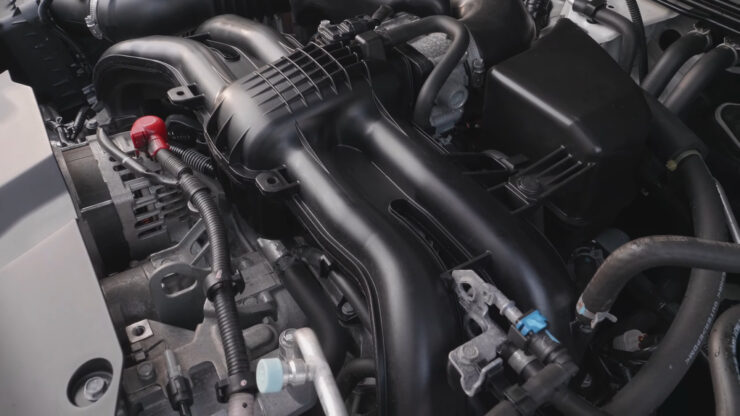Proper preparation is the cornerstone of effectively cleaning a car engine. This phase involves assembling the right tools and materials, understanding the precautions necessary for both the engine and the environment, and setting up your workspace for the task ahead.
Gathering Essential Tools and Materials
The first step in preparing for this job is to gather all the necessary tools and materials. The most important thing is that typical polisher is not a good solution as it is for cleaning the external area.
- Degreaser: Choose a quality degreaser designed specifically for vehicles.
- Brushes: Have a range of sizes available, from small toothbrush-sized brushes for tight spaces to larger brushes for broad surfaces.
- Microfiber Cloths: These are essential for wiping surfaces without leaving lint.
- Plastic Bags and Tape: These are used to cover and protect sensitive parts from water damage.
- Garden Hose or Pressure Washer: Necessary for rinsing off the degreaser (a pressure washer is optional but can be more effective).
- Protective Gear: Including gloves and safety glasses to protect your hands and eyes from chemicals.
- Compressed Air: If available, this can be useful for blowing out debris from tight spaces.

Ensure Safety
Your safety and the safety of the engine are paramount.
- Cool Engine: Always ensure it is cool to the touch before beginning. This reduces the risk of burns and damage to engine components.
- Ventilation: Work in a well-ventilated area to avoid inhaling degreaser fumes.
- Component Protection: Use plastic bags and tape to cover sensitive areas such as the alternator, electrical parts, and air intake. This prevents water and degreaser from causing damage.
- Stable Ground: Make sure your car is parked on a stable, level surface and that you have enough room to move around comfortably.
Set Up Your Workspace
A well-organized workspace is crucial for an efficient process.
- Clear Area: Remove any unnecessary items from around the car to create ample working space.
- Tool Accessibility: Arrange your tools and materials so that they are easily accessible throughout the cleaning process.
- Waste Disposal: Have a plan for properly disposing of any waste, including dirty water and used cloths.
Deep Cleaning Process
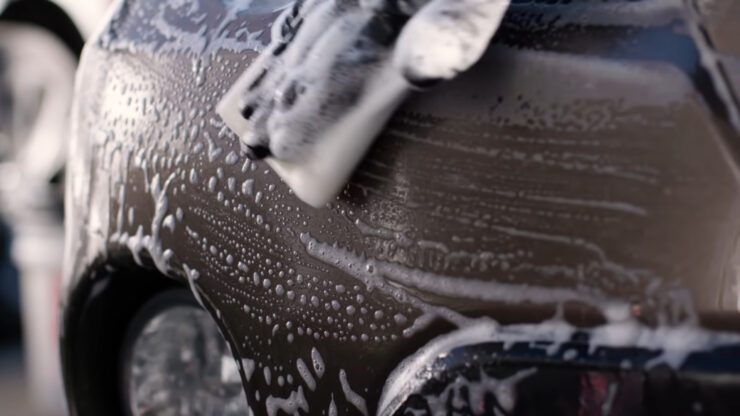
The deep cleaning process is where the real work happens. This stage involves applying degreaser, scrubbing the engine, and then thoroughly rinsing off the the agents.
Apply Degreaser
Choosing the right degreaser and applying it correctly are crucial for effective process.
- Select an Appropriate Degreaser: Opt for a non-corrosive, automotive-specific degreaser. Avoid harsh chemicals that can damage the components.
- Application: Apply the degreaser liberally, starting from the lower areas and moving upwards. This prevents the degreaser from dripping onto you and ensures full coverage.
- Wait Time: Allow the degreaser to sit for a few minutes to break down the oil and grime. However, avoid letting it dry completely, as this can make rinsing more difficult.
Scrubbing and Rinsing
Once the degreaser has been applied, it’s time to start scrubbing:
- Scrubbing: Use your assortment of brushes to gently but thoroughly scrub the engine components. Pay special attention to areas with heavy build-up, but be gentle on sensitive parts.
- Rinsing: After scrubbing, rinse the engine thoroughly with a hose or pressure washer. Be cautious around electrical components and other sensitive areas. The goal is to remove all traces of degreaser and loosened grime.
Drying and Protecting
The final step in the process is to dry and protect.
- Drying: Use microfiber cloths to dry it as much as possible. Removing moisture prevents rust and corrosion.
- Protecting: Once dry, apply a protectant to rubber, plastic, and silicone parts. This can help to preserve these materials and prevent them from cracking or fading.
Additional Steps
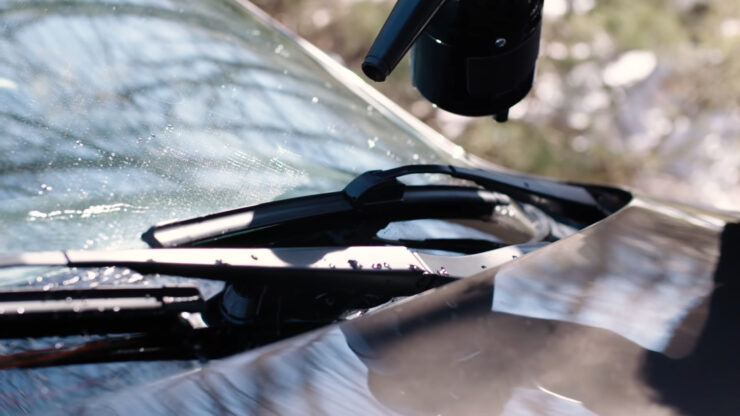
After you are finised, there are several important steps to ensure that your engine is not only clean but also functioning properly.
Check Fluids and Connections
It’s vital to check all fluid levels and connections after cleaning:
- Fluid Levels: Ensure that oil, coolant, and other fluid levels are adequate.
- Connections: Check for any loose or disconnected hoses and electrical connections. This is also an ideal time to look for any signs of wear or leaks.
Start the Engine
Starting after cleaning is an important step:
- Initial Start: Start and let it run for a few minutes. This helps to evaporate any remaining moisture.
- Listen for Irregularities: Pay attention to any unusual noises or signs of misfires. If everything sounds normal, you’ve likely done a thorough job.
Regular Maintenance
Beyond cleaning, regular maintenance is key to proper maintenance:
- Regular Checks: Periodically check and replace fluids, filters, belts, and hoses.
- Follow a Schedule: Adhere to the recommended maintenance schedule for your specific vehicle.
Advanced Tips
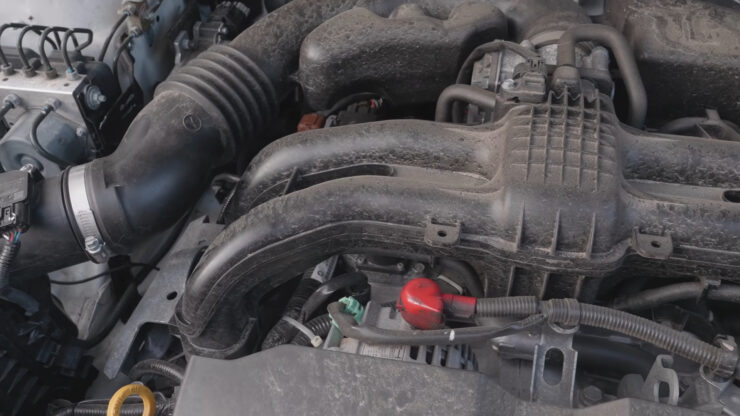
For those looking to go above and beyond in their engine cleaning, there are additional steps and tips that can make a significant difference.
Inspect and Polish
After it is clean and dry, inspection and polishing are the next steps:
- Inspection: Carefully examine all components for any signs of damage or wear.
- Polishing: Use metal polish on chrome or metallic parts to enhance their appearance and prevent rust.
Cleaning Techniques
For the meticulous cleaner, there are more advanced techniques:
- Steam Cleaning: Using a steam cleaner can help remove stubborn grime without the need for harsh chemicals.
- Detailing Brushes: Employing detailing brushes can help you reach the most challenging spots and give your engine a professional-level clean.
Eco-Friendly Practices
Adopting eco-friendly practices can significantly reduce your vehicle’s environmental impact:
- Using Eco-friendly Products: Opt for biodegradable and non-toxic cleaning products when cleaning your engine.
- Emission Checks: Regularly check and maintain your vehicle’s emission system to ensure it meets environmental standards.
How to Ensure Longevity?
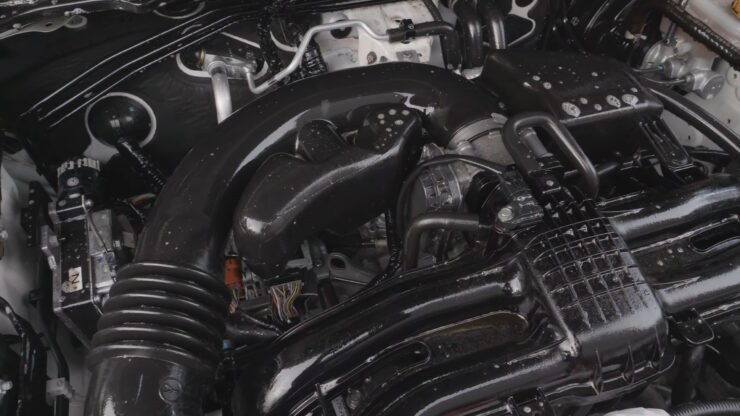
Maintenance goes beyond cleaning; it’s about enhancing its longevity and performance.
Regular Inspection and Tune-up
Consistent inspections and tune-ups are vital for longevity:
- Regular Inspections: Schedule periodic inspections by a professional. They can identify issues that may not be apparent to the untrained eye.
- Tune-ups: Regular tune-ups, including spark plug replacement, timing adjustments, and air filter changes, can significantly improve engine performance and longevity.
Deal With Issues on Time
Proactive problem-solving is key to maintaining engine health:
- Early Detection: Pay attention to any changes in engine performance, sounds, or appearance. Early detection of problems can prevent more severe damage.
- Timely Repairs: Address any identified issues promptly. Delaying repairs can lead to more extensive and expensive damage.
FAQs
Can I wash my engine while its running?
No, you should not wash your engine while it is running. This can cause serious damage to the electrical components and lead to overheating or fire.
How long should I wait after washing my engine?
You should wait at least 15 minutes after washing your engine before starting it. This will allow the water to evaporate and prevent any short circuits or corrosion.
What to avoid when cleaning engine?
You should avoid using high-pressure water, degreasers, or solvents when cleaning your engine. These can harm the rubber seals, hoses, and wires and cause leaks or malfunctions.
What should you avoid when doing engine wash?
You should avoid washing your engine when it is hot, as this can crack the metal parts and create steam that can burn you. You should also avoid spraying water directly into the air intake, alternator, or fuse box, as this can damage the engine.
Is WD-40 good for cleaning car engine?
WD-40 is not a good choice for cleaning your car engine. It is a lubricant and water displacer, not a cleaner. It can leave a greasy residue that can attract dirt and dust and interfere with the performance of your engine.
Last Words
Cleaning your car engine might seem daunting, but with the right tools and knowledge, it’s a manageable and rewarding task. Regular engine cleaning not only keeps your car running smoothly but also extends its lifespan and maintains its value. By following this guide, you can ensure that your engine stays clean and performs at its best.

